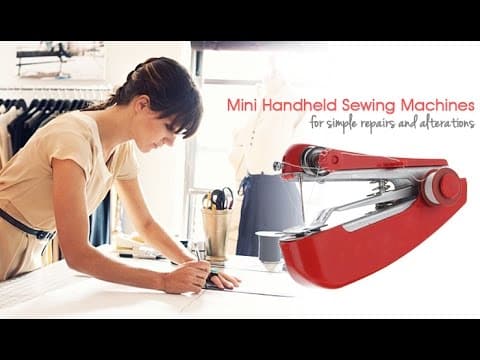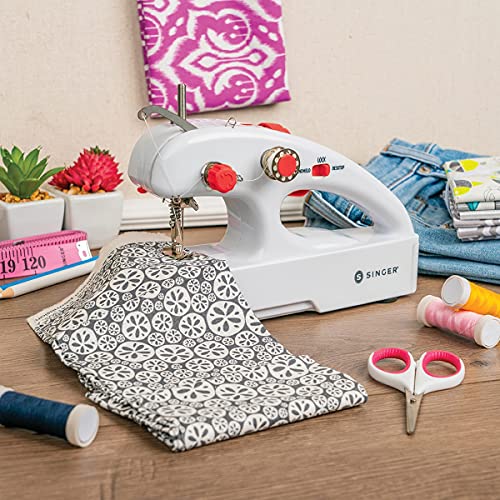
When facing the need to fix or sew something quickly and easily, a Handheld sewing machine is a great option. The best Handheld sewing machines can provide convenience and portability, allowing users to complete simple sewing projects on the go without needing a full-size machine.
Finding the best Handheld sewing machine can be difficult because of the variety of available options. Price, durability, functionality, and ease of use are important when choosing a handheld sewing machine. Additionally, some models may be better suited for specific fabrics or projects.
Our team has reviewed many Handheld sewing machines and can help you choose one that fits your needs. Whether you are looking for a portable option for quick fixes or a backup machine for your larger projects, we recommend a Handheld sewing machine that meets your requirements. Our reviews consider factors such as performance, ease of use, and value for money to help you make an informed decision.
Table of Contents
- Top 5 Handheld Sewing Machine
- SINGER 01663 Stitch Sew Quick Portable Mending Machine
- KPCB Tech Mini Sewing Machine for Beginners with 42 PCS Sewing Kit
- SINGER Stitch Quick + Hand Held Mending Machine
- Sew Mighty Mini Sewing Machine
- MICHLEY ZDML-2 Handheld Single-Thread Sewing Machine
- How To Choose The Best Handheld Sewing Machine
- Frequently Asked Questions About Handheld Sewing Machines
- What types of fabrics can a handheld sewing machine handle?
- How does a handheld sewing machine work?
- Are handheld sewing machines suitable for beginners?
- Can handheld sewing machines replace traditional sewing machines?
- What features should I look for when buying a handheld sewing machine?
- How do I thread a handheld sewing machine?
- Can I use a handheld sewing machine to sew zippers or buttons?
- What is the price range for handheld sewing machines?
- How long do handheld sewing machines typically last?
- Can I use a handheld sewing machine for heavy-duty sewing projects?
- What are some popular brands of handheld sewing machines?
Top 5 Handheld Sewing Machine
SINGER 01663 Stitch Sew Quick Portable Mending Machine
The SINGER 01663 Stitch Sew Quick Portable Mending Machine stands out as one of the best HandHeld Sewing Machines on the market due to its exceptional portability and ease of use. Whether you’re a seasoned seamstress or a beginner, this device simplifies quick mending and sewing tasks.
 This sewing machine offers three standout features. First, it provides seamless stitching, allowing users to precision mend clothes, curtains, or fabric. Second, its compact design ensures it’s ideal for on-the-go sewing, making it perfect for travelers or those who need quick fixes. Lastly, the machine’s durability ensures it can withstand frequent use. These features provide convenience and cost savings for users.
This sewing machine offers three standout features. First, it provides seamless stitching, allowing users to precision mend clothes, curtains, or fabric. Second, its compact design ensures it’s ideal for on-the-go sewing, making it perfect for travelers or those who need quick fixes. Lastly, the machine’s durability ensures it can withstand frequent use. These features provide convenience and cost savings for users.
The SINGER 01663 is best suited for people who need a portable, easy-to-use sewing machine for quick repairs. It’s an excellent choice for anyone looking to mend their garments without the hassle of a full-sized sewing machine. It’s worth recommending for its functionality and convenience.
Pros:
- Portable and lightweight
- Easy to use
- Durable build
- Affordable
- Battery-powered for cordless operation
Cons:
- Limited for complex sewing projects
- Limited stitch options
KPCB Tech Mini Sewing Machine for Beginners with 42 PCS Sewing Kit
The KPCB Tech Mini Sewing Machine is one of the best HandHeld Sewing Machines due to its compact and lightweight design, making it perfect for small sewing tasks and beginners.
 This sewing machine boasts three notable features. First, it offers a foot pedal and manual hand switch for sewing control, allowing users to choose their preferred method. Second, it provides double-thread stitching for added durability. Lastly, it has a built-in LED light that illuminates the sewing area, aiding precision and reducing eye strain.
This sewing machine boasts three notable features. First, it offers a foot pedal and manual hand switch for sewing control, allowing users to choose their preferred method. Second, it provides double-thread stitching for added durability. Lastly, it has a built-in LED light that illuminates the sewing area, aiding precision and reducing eye strain.
The KPCB Tech Mini Sewing Machine is suitable for those who require a portable, versatile sewing tool. It’s particularly well-suited for beginners due to its user-friendly design. This machine is recommended for light sewing and quick repairs.
Pros:
- Compact and portable
- Dual sewing control options
- Built-in LED light
- Affordable
- Suitable for beginners
Cons:
- Not suitable for heavy-duty tasks
- Limited stitch options
SINGER Stitch Quick + Hand Held Mending Machine
The SINGER Stitch Quick + Hand Held Mending Machine is one of the Best HandHeld Sewing Machines due to its reputable brand, known for quality sewing products. It combines portability with versatility, making it a favorite for on-the-go sewers and those seeking quick fixes.
 This machine excels with three key features. First, it offers two-thread stitching, ensuring secure and durable repairs. Second, its lightweight design and cordless operation make it ideal for small sewing tasks anywhere. Lastly, it includes a sewing light, enhancing visibility for precise work. These features provide convenience and quality results for users.
This machine excels with three key features. First, it offers two-thread stitching, ensuring secure and durable repairs. Second, its lightweight design and cordless operation make it ideal for small sewing tasks anywhere. Lastly, it includes a sewing light, enhancing visibility for precise work. These features provide convenience and quality results for users.
The SINGER Stitch Quick + is best suited for individuals who need a reliable handheld sewing machine for quick mending and small projects. It’s highly recommended for beginners and experienced sewers, offering a perfect balance of portability and functionality.
Pros:
- Trusted brand
- Cordless and lightweight
- Two-thread stitching
- Built-in sewing light
- Easy to use
Cons:
- Limited for complex projects
- Battery-powered, may require spares
Sew Mighty Mini Sewing Machine
The Sew Mighty Mini Sewing Machine is among the Best HandHeld Sewing Machines with its compact, easy-to-use design, perfect for novices and occasional sewers. It offers a cost-effective solution for basic sewing needs.
 This machine excels with three standout features. Firstly, it has a double-thread capability, ensuring sturdier stitches. Second, it provides adjustable speed control, allowing users to tailor their sewing pace. Lastly, its lightweight design makes it highly portable, ideal for small sewing projects at home or on the go.
This machine excels with three standout features. Firstly, it has a double-thread capability, ensuring sturdier stitches. Second, it provides adjustable speed control, allowing users to tailor their sewing pace. Lastly, its lightweight design makes it highly portable, ideal for small sewing projects at home or on the go.
The Sew Mighty Mini is most suitable for beginners or casual sewers looking for a straightforward, budget-friendly sewing machine. While unsuitable for heavy-duty tasks, it offers a reliable option for basic sewing and repairs.
Pros:
- Affordable
- Double-thread stitching
- Adjustable speed control
- Lightweight and portable
- Ideal for beginners
Cons:
- Not suitable for heavy fabrics
- Limited stitch variety
MICHLEY ZDML-2 Handheld Single-Thread Sewing Machine
The MICHLEY ZDML-2 Handheld Single-Thread Sewing Machine stands out as one of the Best HandHeld Sewing Machines due to its simplicity and compact design. It’s perfect for quick fixes and small sewing tasks.
 This machine excels with three primary features. First, it offers single-thread stitching, making it easy for beginners to operate. Second, it has a user-friendly, one-handed operation, simplifying sewing even for those new to it. Its small size and portability make it suitable for on-the-spot repairs and travel.
This machine excels with three primary features. First, it offers single-thread stitching, making it easy for beginners to operate. Second, it has a user-friendly, one-handed operation, simplifying sewing even for those new to it. Its small size and portability make it suitable for on-the-spot repairs and travel.
The MICHLEY ZDML-2 is best for beginners and individuals who require an uncomplicated sewing machine for basic mending and lightweight sewing. While it’s not ideal for complex projects, it serves its purpose well.
Pros:
- Simple operation
- One-handed use
- Compact and portable
- Affordable
- Suitable for beginners
Cons:
- Limited for heavy fabrics
- Basic stitching options
How To Choose The Best Handheld Sewing Machine
A handheld sewing machine may be the perfect option if you are looking for a compact and portable sewing machine. Here are some factors to consider when choosing the best handheld sewing machine:
1. Size and Weight
The size and weight of the handheld sewing machine are important considerations since they will impact its portability and ease of use. Look for a machine that is lightweight and easy to carry around.
2. Stitching Options
Check the machine’s stitching options and see if they match your needs. The best handheld sewing machines should offer straight and zigzag stitches and adjustable stitch lengths.
3. Power Source
Determine whether you want a machine with batteries, a power cord, or both. A battery-operated machine provides greater mobility, but it can be costly to replace the batteries.
4. Accessories
Some handheld sewing machines have needles, bobbins, and thread accessories. Check if the machine you are interested in purchasing includes these accessories or if they need to be bought separately.
5. Durability
The best handheld sewing machines are made of durable materials and can withstand frequent use. Look for machines with sturdy construction that can handle different types of fabrics.
6. Price
Consider your budget when looking for a handheld sewing machine. Prices vary widely, but a higher price tag does not always guarantee better quality.
7. Brand Reputation
Choose a brand with a good reputation in the market, which indicates that they produce quality products and provide excellent customer service.
8. Reviews and Ratings
Read customer reviews and ratings before purchasing a handheld sewing machine. This will give you an idea of how well the machine performs and whether it meets users’ expectations.
In summary, choosing the best handheld sewing machine requires considering factors such as size and weight, stitching options, power source, accessories, durability, price, brand reputation, and reviews. With these factors in mind, you can find the perfect handheld sewing machine that fits your needs and budget.
Frequently Asked Questions About Handheld Sewing Machines
Handheld sewing machines are a convenient and portable option for small sewing projects. If you’re considering purchasing a handheld sewing machine, you may have questions about its functionality, performance, and features. Here are some common questions and answers to help you make an informed decision.
What types of fabrics can a handheld sewing machine handle?
Most handheld sewing machines can handle light to medium-weight fabrics such as cotton, polyester, silk, and denim. However, they may struggle with thicker fabrics like leather or canvas.
How does a handheld sewing machine work?
A handheld sewing machine uses a single thread and a bobbin thread to create a lockstitch. The machine is operated by holding it in one hand and guiding the fabric with the other. Some handheld sewing machines require batteries or a power adapter to function.
Are handheld sewing machines suitable for beginners?
Handheld sewing machines can be a good option for beginners just starting with sewing. They are easy to use, portable, and affordable. However, they may not have all the features and capabilities of a traditional sewing machine.
Can handheld sewing machines replace traditional sewing machines?
Handheld sewing machines are not designed to replace traditional sewing machines. They are best used for small and quick sewing projects or repairs on the go. Traditional sewing machines have more features and capabilities and can handle various fabrics and projects.
What features should I look for when buying a handheld sewing machine?
When buying a handheld sewing machine, consider its weight, portability, ease of use, stitch options, and power source. Look for a machine with adjustable stitch lengths and widths, a built-in thread cutter, and a free arm for sewing cuffs and sleeves.
How do I thread a handheld sewing machine?
Threading a handheld sewing machine can vary depending on the model. However, most machines will have a diagram or instructions in the packaging. Following the instructions carefully is essential to ensure the machine is threaded correctly.
Some handheld sewing machines may be able to sew zippers or buttons, but it will depend on the machine’s features and capabilities. It’s essential to read the manufacturer’s instructions and test the machine on a scrap fabric before attempting to sew zippers or buttons on a project.
What is the price range for handheld sewing machines?
Handheld sewing machines can range in price from around $15 to $80, depending on the brand, features, and capabilities. It’s important to determine your sewing needs and budget before purchasing.
How long do handheld sewing machines typically last?
The lifespan of a handheld sewing machine will depend on its usage and maintenance. A good quality handheld sewing machine should last several years with proper care and occasional maintenance.
Can I use a handheld sewing machine for heavy-duty sewing projects?
Handheld sewing machines are not designed for heavy-duty sewing projects. They are best used for small and quick sewing projects or repairs on the go. A traditional sewing machine or a heavy-duty sewing machine is recommended for heavy-duty projects.
What are some popular brands of handheld sewing machines?
Some popular brands of handheld sewing machines include Singer, Brother, Michley, and Lychee. It’s important to research the brand and read reviews before purchasing.

